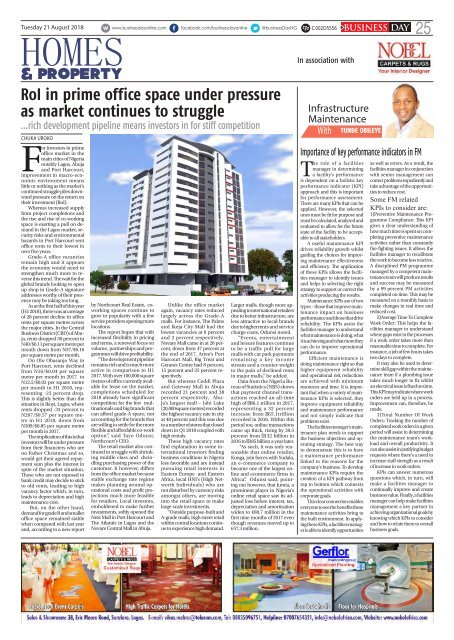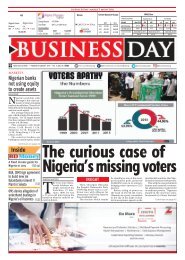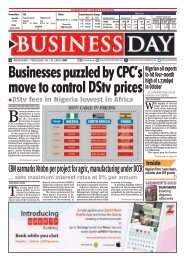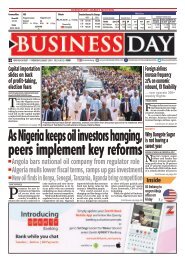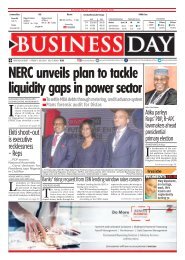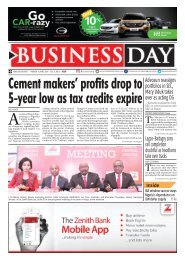BusinessDay 21 Aug 2018
Create successful ePaper yourself
Turn your PDF publications into a flip-book with our unique Google optimized e-Paper software.
Tuesday <strong>21</strong> <strong>Aug</strong>ust <strong>2018</strong><br />
C002D5556<br />
BUSINESS DAY<br />
25<br />
In association with<br />
RoI in prime office space under pressure<br />
as market continues to struggle<br />
…rich development pipeline means investors in for stiff competition<br />
CHUKA UROKO<br />
For investors in prime<br />
office market in the<br />
main cities of Nigeria<br />
notably Lagos, Abuja<br />
and Port Harcourt,<br />
improvement in macro-economic<br />
environment means<br />
little or nothing as the market’s<br />
continued struggle piles downward<br />
pressure on the return on<br />
their investment (RoI).<br />
Whereas increased supply<br />
from project completions and<br />
the rise and rise of co-working<br />
space is exerting a pull on demand<br />
in the Lagos market, security<br />
risks and environmental<br />
hazards in Port Harcourt sent<br />
office rents to their lowest in<br />
over five years.<br />
Grade-A office vacancies<br />
remain high and it appears<br />
the economy would need to<br />
strengthen much more to reverse<br />
this trend. The wait for the<br />
global brands looking to open<br />
up shop in Grade-A signature<br />
addresses worthy of their presence<br />
may be taking too long.<br />
As at the first half of this year<br />
(H1 <strong>2018</strong>), there was an average<br />
of 28 percent decline in office<br />
rents per square metres across<br />
the major cities. In the Central<br />
Business District (CBD) of Abuja,<br />
rents dropped 30 percent to<br />
N40/$0.11 per square metre per<br />
month down from N57/$0.16<br />
per square metre per month.<br />
On Olu Obasanjo Way in<br />
Port Harcourt, rents declined<br />
from N16/$0.04 per square<br />
metre per month in 2017 to<br />
N12.5/$0.03 per square metre<br />
per month in H1 <strong>2018</strong>, representing<br />
-23 percent drop.<br />
This is slightly better than the<br />
situation in Ikoyi, Lagos, where<br />
rents dropped -33 percent to<br />
N207/$0.57 per square metre<br />
in H1 <strong>2018</strong>, down from<br />
N309/$0.85 per square metre<br />
per month in 2017.<br />
The implication of this is that<br />
investors will be under pressure<br />
from their financiers who are<br />
no Father Christmas and so,<br />
would get their agreed repayment<br />
sum plus the interest in<br />
spite of the market situation.<br />
Those who are not exposed to<br />
bank credit may decide to stick<br />
to old rents, leading to high<br />
vacancy factor which, in turn,<br />
leads to depreciation and high<br />
maintenance cost.<br />
But, on the other hand,<br />
demand for grade B and smaller<br />
office space remained stable<br />
when compared with last year<br />
and, according to a new report<br />
by Northcourt Real Estate, coworking<br />
spaces continue to<br />
grow in popularity with a few<br />
service providers opening more<br />
locations.<br />
The report hopes that with<br />
increased flexibility in pricing<br />
and terms, a renewed focus on<br />
volume, partnerships and programmes<br />
will drive profitability.<br />
“The development pipeline<br />
remains rich and is much more<br />
active in comparison to H1<br />
2017. With over 100,000 square<br />
metres of office currently available<br />
for lease on the market,<br />
completions scheduled for<br />
<strong>2018</strong> already have significant<br />
competition for the few multinationals<br />
and big brands that<br />
can afford grade-A space, not<br />
accounting for the brands that<br />
are willing to settle for the more<br />
flexible and affordable co-work<br />
option”, said Tayo Odunsi,<br />
Northcourt’s CEO.<br />
The retail market also continued<br />
to struggle with shrinking<br />
middle class and dwindling<br />
purchasing power of the<br />
customer. It however, differs<br />
from the office market because<br />
stable exchange rate regime<br />
makes planning around operational<br />
costs and profit projections<br />
much more feasible<br />
for retailers. Local investors,<br />
emboldened to make further<br />
investments, softly opened the<br />
Next Mall in Port Harcourt and<br />
The Atlantic in Lagos and the<br />
Novare Central Mall in Abuja.<br />
Unlike the office market<br />
again, vacancy rates reduced<br />
largely across the Grade-A<br />
malls. For instance, The Palms<br />
and Ikeja City Mall had the<br />
lowest vacancies at 0 percent<br />
and 2 percent respectively.<br />
Novare Mall came in at 28 percent,<br />
down from 47 percent at<br />
the end of 2017. Artee’s Port<br />
Harcourt Mall, Big Treat and<br />
Genesis Centre had 8 percent,<br />
15 percent and 25 percent respectively.<br />
But whereas Ceddi Plaza<br />
and Gateway Mall in Abuja<br />
recorded <strong>21</strong> percent and 38<br />
percent respectively, Abuja’s<br />
largest mall – Jabi Lake<br />
(20,000square metres) recorded<br />
the highest vacancy rate in city<br />
at 40 percent and this was due<br />
to a number of stores that closed<br />
down in Q1 <strong>2018</strong> coupled with<br />
high rentals.<br />
These high vacancy rates<br />
find explanation in some international<br />
investors finding<br />
business conditions in Nigeria<br />
less favorable and are instead<br />
pursuing retail interests in<br />
Eastern Europe and Eastern<br />
Africa, local HNI’s (High Networth<br />
Individuals) who are<br />
not disturbed by currency risks<br />
amongst others, are moving<br />
into the retail space to make<br />
large-scale investments.<br />
“Outside purpose-built and<br />
A-grade malls, high street retail<br />
within central locations continue<br />
to experience high demand.<br />
Larger malls, though more appealing<br />
to international retailers<br />
due to better infrastructure, are<br />
less attractive to local brands<br />
due to higher rents and service<br />
charge costs, Odunsi noted.<br />
“Events, entertainment<br />
and leisure features continue<br />
to be a traffic pull for large<br />
malls with car park payments<br />
remaining a key income<br />
stream and a counter-weight<br />
to the pain of declined rents<br />
in major malls,” he added.<br />
Data from the Nigeria Bureau<br />
of Statistics (NBS) shows<br />
that payment channel transactions<br />
reached an all-time<br />
high of ₦86.1 trillion in 2017,<br />
representing a 32 percent<br />
increase from ₦65.1trillion<br />
recorded in 2016. Within this<br />
period too, online transactions<br />
came up thick, rising by 39.5<br />
percent from ₦132 billion in<br />
2016 to ₦185 billion a year later.<br />
“As such, it was only reasonable<br />
that online retailer,<br />
Konga, join forces with Yudala,<br />
an e-commerce company to<br />
become one of the largest online<br />
and ecommerce firms in<br />
Africa”, Odunsi said, pointing<br />
out however, that Jumia, a<br />
prominent player in Nigeria’s<br />
online retail space saw its adjusted<br />
loss before interest, tax,<br />
depreciation and amortisation<br />
widen to €80.7 million in the<br />
first nine months of 2017 even<br />
though revenues moved up to<br />
€57.3 million.<br />
Infrastructure<br />
Maintenance<br />
With<br />
Tunde Obileye<br />
Importance of key performance indicators in FM<br />
The role of a facilities<br />
manager in determining<br />
a facility’s performance<br />
is dependent on a holistic key<br />
performance indicator (KPI)<br />
approach and this is important<br />
for performance assessment.<br />
There are many KPIs that can be<br />
applied. However, the selected<br />
ones must be fit for purpose and<br />
must be calculated, analyzed and<br />
evaluated to allow for the future<br />
state of the facility to be acceptable<br />
to all stakeholders.<br />
A useful maintenance KPI<br />
drives reliability growth whilst<br />
guiding the choices for improving<br />
maintenance effectiveness<br />
and efficiency. The application<br />
of these KPIs allows the facilities<br />
manager to identify issues<br />
and helps in selecting the right<br />
strategy to support or correct the<br />
activities producing the results.<br />
Maintenance KPIs are of two<br />
types – those that improve maintenance<br />
impact on business<br />
performance and those that drive<br />
reliability. The KPIs assist the<br />
facilities manager to understand<br />
what maintenance is doing, what<br />
it is achieving and what more they<br />
can do to improve operational<br />
performance.<br />
Efficient maintenance is<br />
doing maintenance right so that<br />
higher equipment reliability<br />
and operational risk reductions<br />
are achieved with minimum<br />
resources and time. It is important<br />
that when a variety of maintenance<br />
KPIs is selected, they<br />
improve equipment reliability<br />
and maintenance performance<br />
and not simply indicate that<br />
problems exist.<br />
The facilities manager’s maintenance<br />
plan needs to support<br />
the business objectives and operating<br />
strategy. The best way<br />
to demonstrate this is to have<br />
a maintenance performance<br />
linked to the reasons for the<br />
company’s business. To develop<br />
maintenance KPIs require the<br />
creation of a KPI pathway from<br />
top to bottom which connects<br />
the operational activities with<br />
corporate goals.<br />
This clear connection enables<br />
everyone to see the benefits these<br />
maintenance activities bring to<br />
the built environment. In applying<br />
these KPIs, a facilities manager<br />
is able to identify opportunities<br />
as well as errors. As a result, the<br />
facilities manager in conjunction<br />
with senior management can<br />
correct problems expediently and<br />
take advantage of the opportunities<br />
to reduce cost.<br />
Some FM related<br />
KPIs to consider are:<br />
1)Preventive Maintenance Programme<br />
Compliance: This KPI<br />
gives a clear understanding of<br />
how much time is spent on completing<br />
preventive maintenance<br />
activities rather than constantly<br />
fire-fighting issues. It allows the<br />
facilities manager to recalibrate<br />
the work to become less reactive.<br />
A disciplined PM programme<br />
managed by a competent maintenance<br />
team will produce results<br />
and success may be measured<br />
by a 99 percent PM activities<br />
completed on time. This may be<br />
measured on a monthly basis to<br />
make changes in real time and<br />
reduced cost.<br />
2)Average Time To Complete<br />
Work Order: This helps the facilities<br />
manager to understand<br />
where gaps exist in the processes<br />
if a work order takes more than<br />
reasonable time to complete. For<br />
instance, a job of few hours takes<br />
two days to complete.<br />
It may also be used to determine<br />
skill gap within the maintenance<br />
team if a plumbing issue<br />
takes much longer to fix whilst<br />
an electrical issue is fixed on time.<br />
This KPI may indicate where work<br />
orders are held up in a process.<br />
Improvement can, therefore, be<br />
made.<br />
3)Total Number Of Work<br />
Orders: Tracking the number of<br />
completed work orders in a given<br />
period will assist in determining<br />
the maintenance team’s workload<br />
and overall productivity. It<br />
can also assist in justifying budget<br />
requests where there’s a need to<br />
increase staff strength as a result<br />
of increase in work orders.<br />
KPIs can answer numerous<br />
questions which, in turn, will<br />
make a facilities manager to<br />
continually improve and create<br />
business value. Finally, a facilities<br />
manager can help make facilities<br />
management a key partner in<br />
achieving organizational goals by<br />
knowing which KPIs to consider<br />
and how to relate them to overall<br />
business goals.


